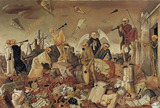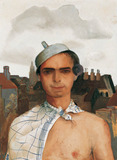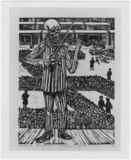Felix Nussbaum: Orgelmann, painting (1943)
Felix Nussbaum: Orgelmann, painting (1943)
The last survivor of the catastrophe sits with his back to an apocalyptic urban scene: an organ grinder, the melancholy alter-ego of the painter Felix Nussbaum. He is leaning against the long since silenced organ and looks contemplatively into the emptiness. Ribs jut out from the pavements, black plague flags hang from the blood-smeared walls of buildings. The end-times scene is identifiable as the Rue Archimède in Brussels. From 1937 onwards until his arrest and internment on 10 May 1940, Nussbaum and his wife Felka Platek lived in this street. After Nussbaum's escape from the camp, the two artists returned to the street in 1943 and were hidden from the German occupying force in an attic by friends.
In this hiding place Nussbaum resumed work on his painting Orgelmann, of which a first version was made in June 1942. X-rays give indications of which parts were revised by the artist. He replaced metal organ pipes with bones. Nussbaum placed a green cloak over the organ; the colour stands for death and destruction in Nussbaum's works. The only living thing in the world depicted here is a fly on the hand organ. A collapsing Doric column stands as a symbol of the Occidental culture destroyed by Nazism, a motif which Nussbaum also used in the 1935 painting Komisches Konzert.






